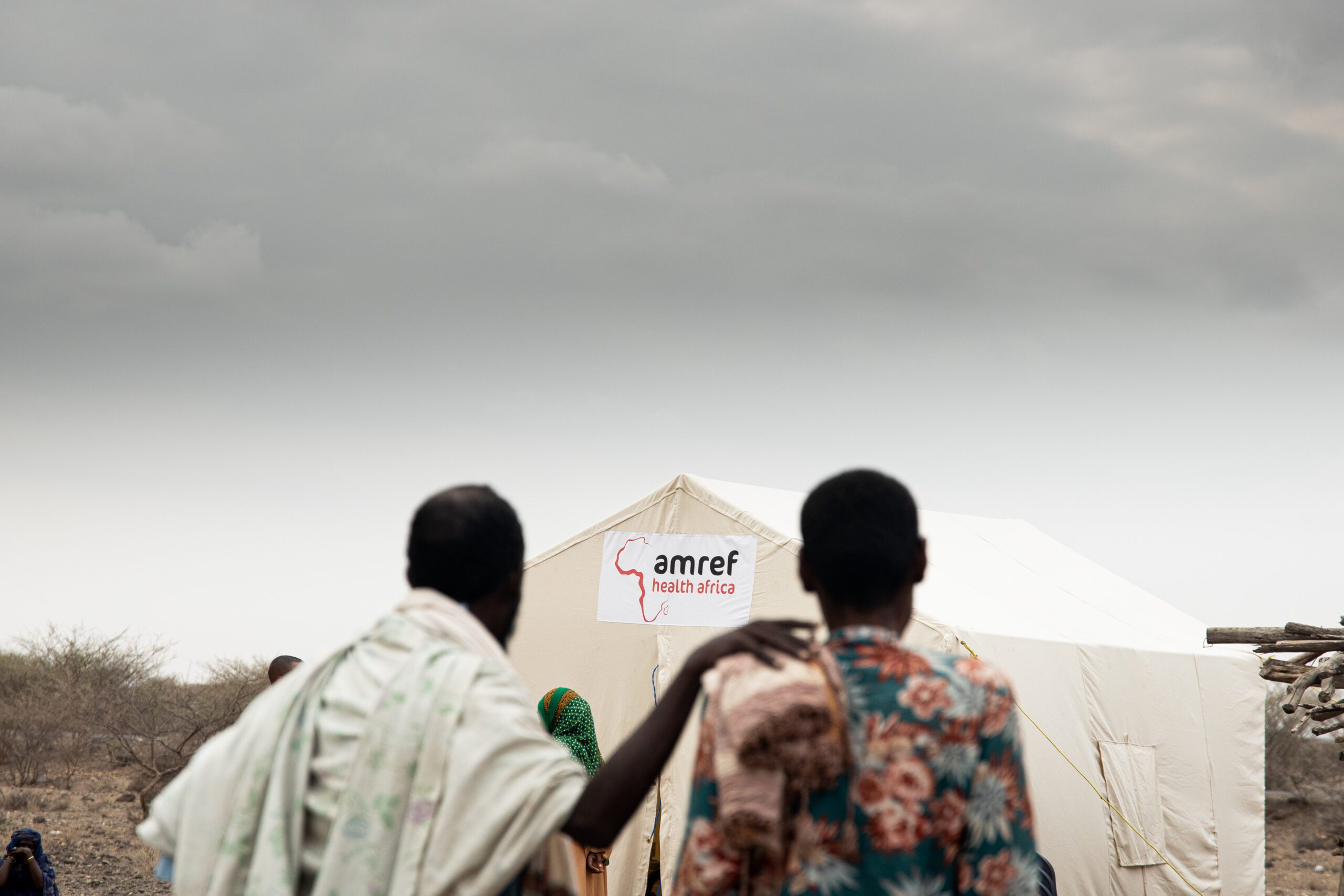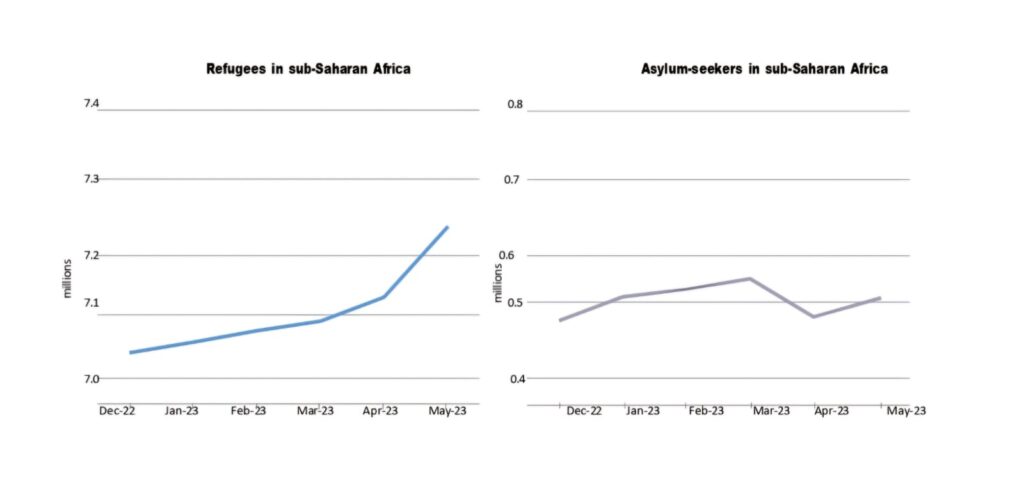

Men standing by a tent for Mobile and Health Nutrition (MHNT) service in Chifra woreda, Afar region Ethiopia. The service is given by Chifra Woreda Health Office and Health Nutrition team in collaboration with Amref Health Africa, Improving Primary Health Care Service Delivery Project.
By: Shadrack Gikonyo, Tonny Kapsandui, Moreen Mwenda
The global refugee population has been steadily increasing over the past seven years, reaching 108.4 million forcibly displaced people by the end of 2022. This surge, driven by persecution, conflict, violence, and human rights violations, includes 36.4 million refugees and 62.2 million internally displaced persons (IDPs) as of mid-2023. Alarmingly, the first six months of 2023 alone saw 6.8 million new internal displacements.
Low- and middle-income countries host the majority—76%—of the world’s refugees, placing immense pressure on their already stretched financial and health systems. Sub-Saharan Africa, in particular, is a major hub for displaced populations, hosting one in five refugees globally. The East and Horn of Africa and the Great Lakes region alone accommodate 4.7 million refugees, with Uganda hosting the largest share at 1.5 million. This influx exacerbates existing challenges in health financing, especially against the backdrop of global funding gaps for humanitarian needs, such as those seen in Sudan (93%), Ethiopia (83%), and Somalia (75%) in 2023.


Healthcare financing implications of the refugees in Uganda
In Uganda, refugees face significant barriers to healthcare access. According to the World Health Organization (WHO), the experience of migration is a key determinant of health, yet refugees remain among the most vulnerable groups due to discrimination, poor living conditions, and limited access to health services. Common health issues among Uganda’s refugee population include upper respiratory tract infections (23%), malaria (19%), and lower respiratory tract infections (7%). Non-communicable diseases and mental health conditions, though less prevalent, are growing concerns. Other health challenges include skin conditions and gastrointestinal illnesses caused by inadequate washing facilities and poor sanitation.
Among Ugandan refugees, the leading causes of illness remained upper respiratory tract infection (23%), malaria (19 %) and lower respiratory tract infection (7%). Non-communicable diseases accounted for 5% of consultations while mental health services made up 2 per cent. Other common health conditions seen in refugee camps include hypothermia, burns and gastrointestinal illnesses. Skin conditions, including scabies, and the spread of parasites due to a lack of washing facilities and clean bedding are widely reported.
Hosting of refugees in Uganda is made costlier to the health systems by disease outbreaks. Firstly, In September 2022, Uganda declared an Ebola disease outbreak caused by the Sudan ebolavirus species, against which there are no approved therapeutics and vaccines. It was the country’s first Sudan ebolavirus outbreak in a decade and its fifth of this kind of Ebola. During this outbreak, there were 164 cases (142 confirmed and 22 probable), 55 confirmed deaths and 87 recovered patients.
Outbreaks of Ebola Virus Disease (EVD) in parts of the Democratic Republic of the Congo such as Beni, Butembo and Bunia where majority of the refugees come from presents serious public health challenges. This requires public health workers, especially on the Ugandan side of the border, to be extra vigilant – screening travelers for any EVD signs and symptoms and managing them appropriately.
In January 2024, Uganda reported a cholera outbreak in refugee settlement camps in the West Nile district of Adjumani. Though health authorities quickly contained the outbreak, treating and discharging all 13 cholera patients, the incident underscores the volatile public health dynamics of refugee-hosting areas. Frequent outbreaks and the need for robust community engagement strategies highlight the importance of reliable and sustainable health financing mechanisms.
Urban areas like Kampala face unique challenges, as approximately 2,000 refugees settle in the city weekly without passing through official border points. This unregulated influx complicates surveillance efforts and heightens the risk of disease outbreaks. Refugees often seek safety and better access to healthcare in urban settings, further straining already stretched health services in these areas.
Global efforts and path forward
Recognising the growing need for coordinated responses, the World Health Organization established the Department of Health and Migration in 2020 to address health, migration, and displacement issues globally. In Uganda, the Country Refugee Response Plan (UCRRP) for 2024–2025 aims to improve health outcomes for refugees. Developed by the Office of the Prime Minister (OPM) and the UNHCR, this plan appeals for $857.9 million in 2024 to meet refugee needs, slightly higher than the 2023 appeal of $846 million. The December 2023 Global Refugee Forum in Geneva resulted in significant pledges, including $2.2 billion to support refugee responses, but funding gaps remain substantial.
While these initiatives are a step forward, the need for evidence-based, cost-effective models of healthcare delivery for refugees and migrants in LMICs cannot be overstated. WHO emphasises that health financing models for displaced populations are an understudied area, with little research on the cost-effectiveness of healthcare integration policies. Addressing this gap is critical for ensuring inclusive universal health coverage (UHC) and primary healthcare (PHC) for displaced populations.
Health financing for refugees in Uganda must address several challenges. Disease outbreaks linked to refugee influxes require consistent funding for surveillance, early warning systems, and emergency responses. Urbanisation trends demand innovative approaches to healthcare delivery, particularly in informal settlements. Additionally, long-term integration policies must balance the needs of host communities with those of refugees to prevent social tensions.
In conclusion, refugee hosting in Uganda has far-reaching implications for health financing, requiring sustainable and inclusive approaches to address the complex health needs of displaced populations. Strengthening health systems, securing reliable funding, and conducting targeted research are essential for building resilience in refugee-hosting countries. As displacement continues to rise globally, Uganda’s experience offers valuable lessons for navigating the intersection of migration, health, and financing.
Achuman Emoni stretches her hands, illustrating the vast distance she has travelled to reach the…
During a session held at Africa Health Agenda International Conference in Kigali, Rwanda, on 4th…
Amref Health Africa, in collaboration with the Turkana County Department of Health Services, introduced the…
Amref Health Africa, in collaboration with the Turkana County Department of Health Services, introduced the…
Over the past six years, Amref Health Africa has positioned itself as a leading voice…
Africa has made significant strides in advocating for health research and development, yet gaps in…